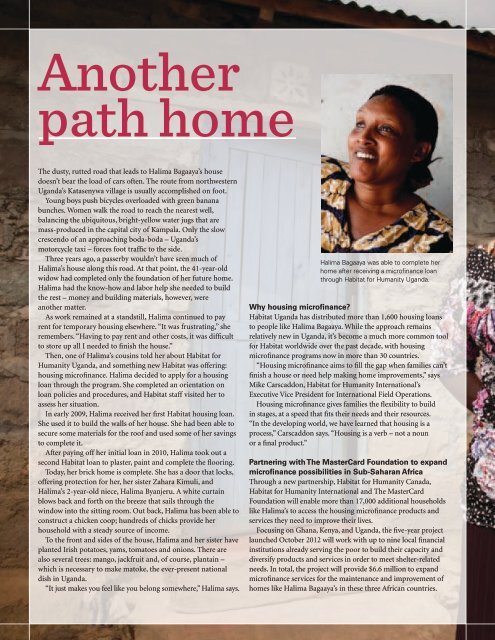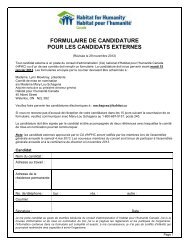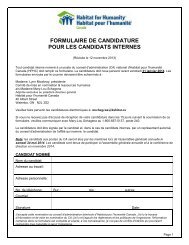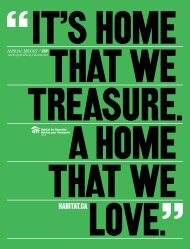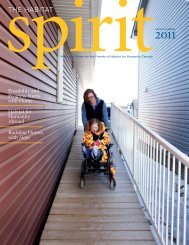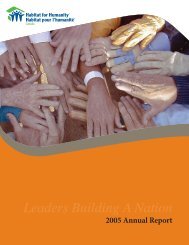habiTaT spiriT Fall/Winter 2012 - Habitat for Humanity Canada
habiTaT spiriT Fall/Winter 2012 - Habitat for Humanity Canada
habiTaT spiriT Fall/Winter 2012 - Habitat for Humanity Canada
Create successful ePaper yourself
Turn your PDF publications into a flip-book with our unique Google optimized e-Paper software.
Another<br />
path home<br />
The dusty, rutted road that leads to Halima Bagaaya’s house<br />
doesn’t bear the load of cars often. The route from northwestern<br />
Uganda’s Katasenywa village is usually accomplished on foot.<br />
Young boys push bicycles overloaded with green banana<br />
bunches. Women walk the road to reach the nearest well,<br />
balancing the ubiquitous, bright-yellow water jugs that are<br />
mass-produced in the capital city of Kampala. Only the slow<br />
crescendo of an approaching boda-boda – Uganda’s<br />
motorcycle taxi – <strong>for</strong>ces foot traffic to the side.<br />
Three years ago, a passerby wouldn’t have seen much of<br />
Halima’s house along this road. At that point, the 41-year-old<br />
widow had completed only the foundation of her future home.<br />
Halima had the know-how and labor help she needed to build<br />
the rest – money and building materials, however, were<br />
another matter.<br />
As work remained at a standstill, Halima continued to pay<br />
rent <strong>for</strong> temporary housing elsewhere. “It was frustrating,” she<br />
remembers. “Having to pay rent and other costs, it was difficult<br />
to store up all I needed to finish the house.”<br />
Then, one of Halima’s cousins told her about <strong>Habitat</strong> <strong>for</strong><br />
<strong>Humanity</strong> Uganda, and something new <strong>Habitat</strong> was offering:<br />
housing microfinance. Halima decided to apply <strong>for</strong> a housing<br />
loan through the program. She completed an orientation on<br />
loan policies and procedures, and <strong>Habitat</strong> staff visited her to<br />
assess her situation.<br />
In early 2009, Halima received her first <strong>Habitat</strong> housing loan.<br />
She used it to build the walls of her house. She had been able to<br />
secure some materials <strong>for</strong> the roof and used some of her savings<br />
to complete it.<br />
After paying off her initial loan in 2010, Halima took out a<br />
second <strong>Habitat</strong> loan to plaster, paint and complete the flooring.<br />
Today, her brick home is complete. She has a door that locks,<br />
offering protection <strong>for</strong> her, her sister Zahara Kimuli, and<br />
Halima’s 2-year-old niece, Halima Byanjeru. A white curtain<br />
blows back and <strong>for</strong>th on the breeze that sails through the<br />
window into the sitting room. Out back, Halima has been able to<br />
construct a chicken coop; hundreds of chicks provide her<br />
household with a steady source of income.<br />
To the front and sides of the house, Halima and her sister have<br />
planted Irish potatoes, yams, tomatoes and onions. There are<br />
also several trees: mango, jackfruit and, of course, plantain –<br />
which is necessary to make matoke, the ever-present national<br />
dish in Uganda.<br />
“It just makes you feel like you belong somewhere,” Halima says.<br />
Halima Bagaaya was able to complete her<br />
home after receiving a microfinance loan<br />
through <strong>Habitat</strong> <strong>for</strong> <strong>Humanity</strong> Uganda.<br />
Why housing microfinance?<br />
<strong>Habitat</strong> Uganda has distributed more than 1,600 housing loans<br />
to people like Halima Bagaaya. While the approach remains<br />
relatively new in Uganda, it’s become a much more common tool<br />
<strong>for</strong> <strong>Habitat</strong> worldwide over the past decade, with housing<br />
microfinance programs now in more than 30 countries.<br />
“Housing microfinance aims to fill the gap when families can’t<br />
finish a house or need help making home improvements,” says<br />
Mike Carscaddon, <strong>Habitat</strong> <strong>for</strong> <strong>Humanity</strong> International’s<br />
Executive Vice President <strong>for</strong> International Field Operations.<br />
Housing microfinance gives families the flexibility to build<br />
in stages, at a speed that fits their needs and their resources.<br />
“In the developing world, we have learned that housing is a<br />
process,” Carscaddon says. “Housing is a verb – not a noun<br />
or a final product.”<br />
partnering with The mastercard Foundation to expand<br />
microfinance possibilities in sub-saharan africa<br />
Through a new partnership, <strong>Habitat</strong> <strong>for</strong> <strong>Humanity</strong> <strong>Canada</strong>,<br />
<strong>Habitat</strong> <strong>for</strong> <strong>Humanity</strong> International and The MasterCard<br />
Foundation will enable more than 17,000 additional households<br />
like Halima’s to access the housing microfinance products and<br />
services they need to improve their lives.<br />
Focusing on Ghana, Kenya, and Uganda, the five-year project<br />
launched October <strong>2012</strong> will work with up to nine local financial<br />
institutions already serving the poor to build their capacity and<br />
diversify products and services in order to meet shelter-related<br />
needs. In total, the project will provide $6.6 million to expand<br />
microfinance services <strong>for</strong> the maintenance and improvement of<br />
homes like Halima Bagaaya’s in these three African countries.<br />
(Above) 37-year-old Echum Hassim Oguta of Bweyale, Uganda is a<br />
house-builder who has never had a decent home of his home be<strong>for</strong>e<br />
now. He migrated to Uganda’s Masindi district from Gulu, in<br />
northern Uganda, when the fighting was fiercest during the<br />
country’s civil war. He and his family stayed in three traditional mud<br />
huts on land provided by the government <strong>for</strong> displaced people. While<br />
living there, Echum built other people’s houses, bringing home extra<br />
building materials when he could. With a microfinance loan from<br />
<strong>Habitat</strong> <strong>for</strong> <strong>Humanity</strong> Uganda’s Masindi branch, he installed<br />
windows and doors, and was able to plaster and concrete his home.<br />
(Below) Echum Hassim Oguta’s 10-year-old son, Mujahid Echum,<br />
walks on the path to his family’s home.<br />
(Left) Christine Tesot of<br />
Bomet, Kenya washes<br />
dishes outside her family’s<br />
home. Christine’s husband,<br />
Kipkorir Tesot, a retired<br />
teacher and subsistence<br />
farmer, was able to complete<br />
construction on his family’s<br />
home after receiving a series<br />
a small loans from <strong>Habitat</strong><br />
Kenya’s microfinance<br />
program. The loans allowed<br />
him to build his home in<br />
stages with materials he<br />
had been saving <strong>for</strong> more<br />
than 10 years.<br />
To donate, participate or advocate, visit www.habitat.ca 11<br />
<strong>Habitat</strong> <strong>for</strong> <strong>Humanity</strong>/Steffan Hacker<br />
<strong>Habitat</strong> <strong>for</strong> <strong>Humanity</strong> international/ezra Millstein <strong>Habitat</strong> <strong>for</strong> <strong>Humanity</strong> international/ezra Millstein


